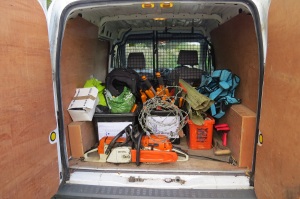Broad bodied chasers
Dragonflies were among the first winged insects to evolve, around 300 million years ago, long before there were dinosaurs. Back then oxygen levels in our atmosphere were much higher than they are now, and dragonflies evolved into giants with wingspans like eagles. Now, the emperor dragonfly, the largest of Britain’s 36 dragonfly species, has a wingspan of a mere 11cm.

2 
1
[1] broad bodied chaser male [2] broad bodied chaser female
Last summer you may have seen male broad bodied chaser dragonflies (Libellula depressa) fighting fiercely for territory over the reserve’s pond. Few species can match a dragonfly’s flying ability; they have four long wings that can beat together or separately allowing them to hover or to fly in any direction at speeds of up to 30mph. The territorial battles over the pond were spectacular.
The successful male grabs a female if she enters his territory; he mates her and guards her while she lays her eggs there. She deposits her eggs in the water, dipping the ovipositor at the tip of her abdomen into the water’s surface for each one. After a couple of weeks, the eggs hatch into nymphs: ferocious aquatic carnivores that live and hunt in the pond for anything up to three years.
If our pond has fed these underwater predators well, May is when the fully-grown broad bodied chaser nymphs will leave the water, climbing up marginal plants in the sheltered border of the pond, and shedding their final skin, to emerge as adults.
[3] broad bodied chaser nymph [4] the marginal plants in the sheltered edge of the pond.
Pause at the pond for a while to watch the drama; the prime broad bodied chaser territory is the just beyond the weir on the Village Green side and the tufts of rushes on the bank make an excellent perching post from which a dragonfly can keep watch for rivals.







